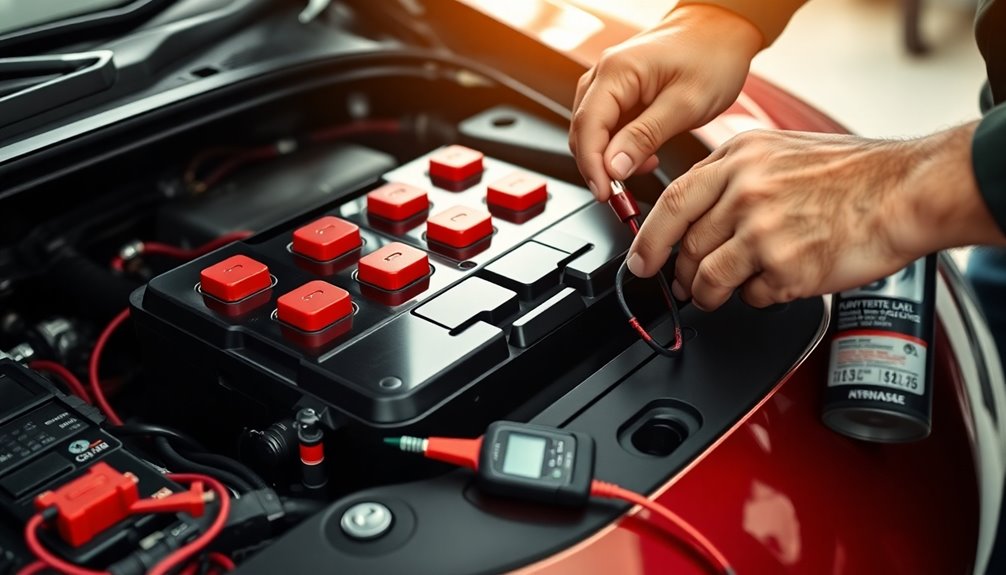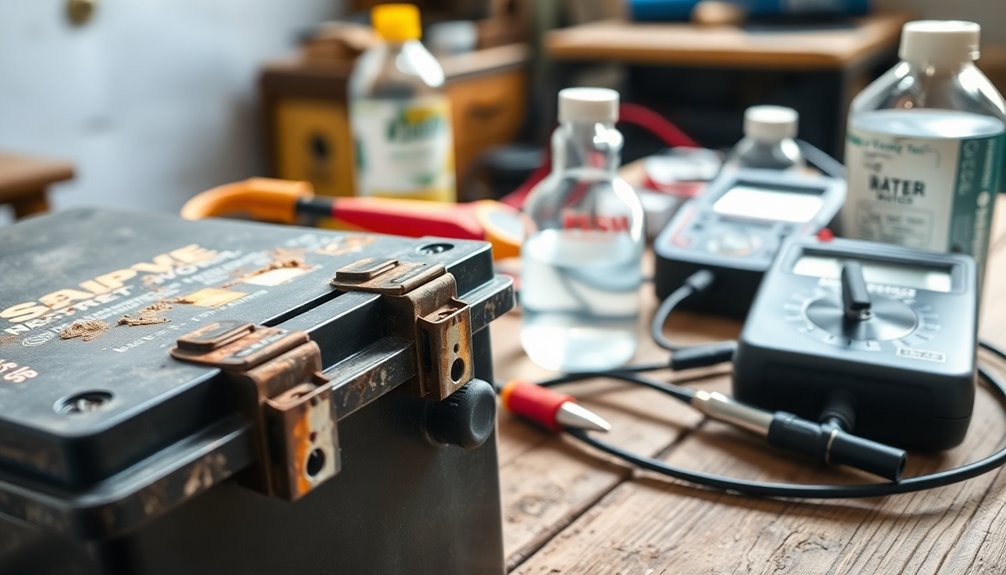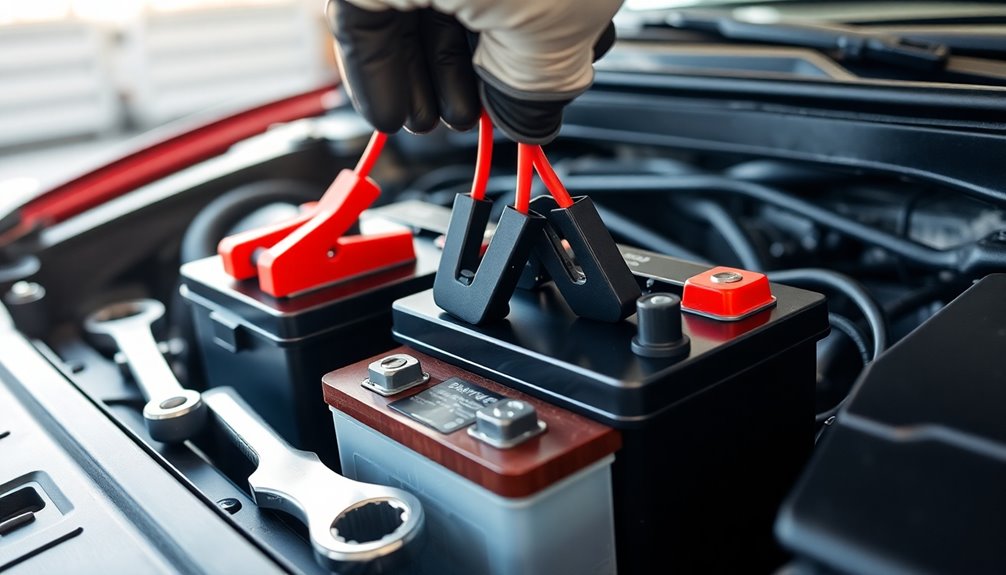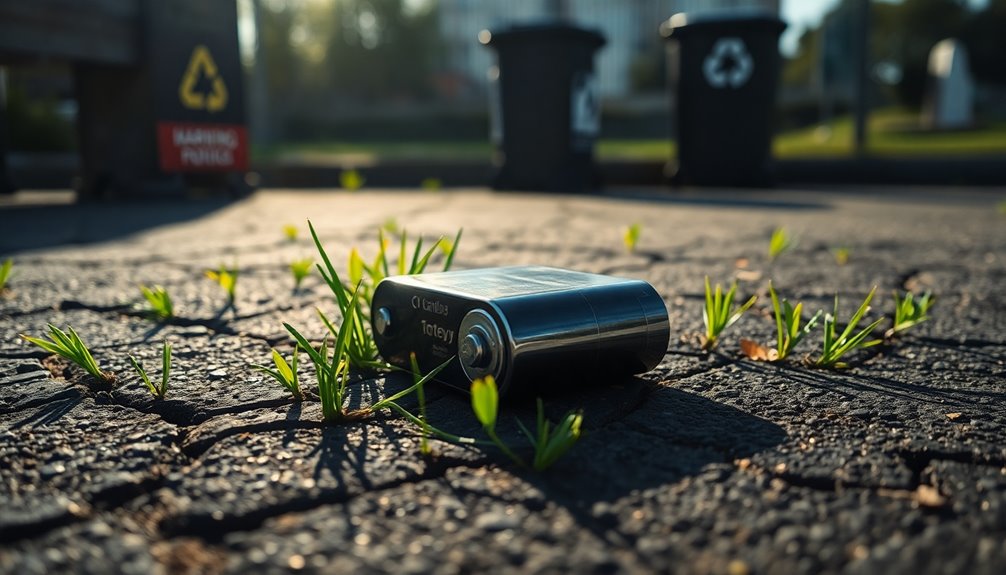After you install a new car battery, take a few important steps to ensure it performs optimally. First, clean the battery terminals with a baking soda solution to remove any corrosion, then apply petroleum jelly for protection. Next, make sure to reset any vehicle settings affected by the battery change. Check the voltage after starting the engine; it should be around 14.7 volts. Regularly monitor the battery's performance metrics, like voltage and Cold Cranking Amps, to predict issues. Keeping track of these details can significantly extend your battery's life and efficiency—there's more to explore on maintaining your battery effectively!
Key Takeaways
- Reset vehicle settings such as ECU memory, radio presets, and navigation according to the owner's manual for optimal functionality.
- Monitor battery voltage; it should read at least 12.6 volts when stationary and around 14.7 volts while the engine is running.
- Conduct regular performance checks, including load testing, to ensure the battery maintains voltage above 9.6 volts under load.
- Apply petroleum jelly or dielectric grease on terminals to prevent corrosion and ensure reliable electrical connections.
- Keep records of battery replacement and maintenance activities to track performance and predict lifespan effectively.
Safety Precautions
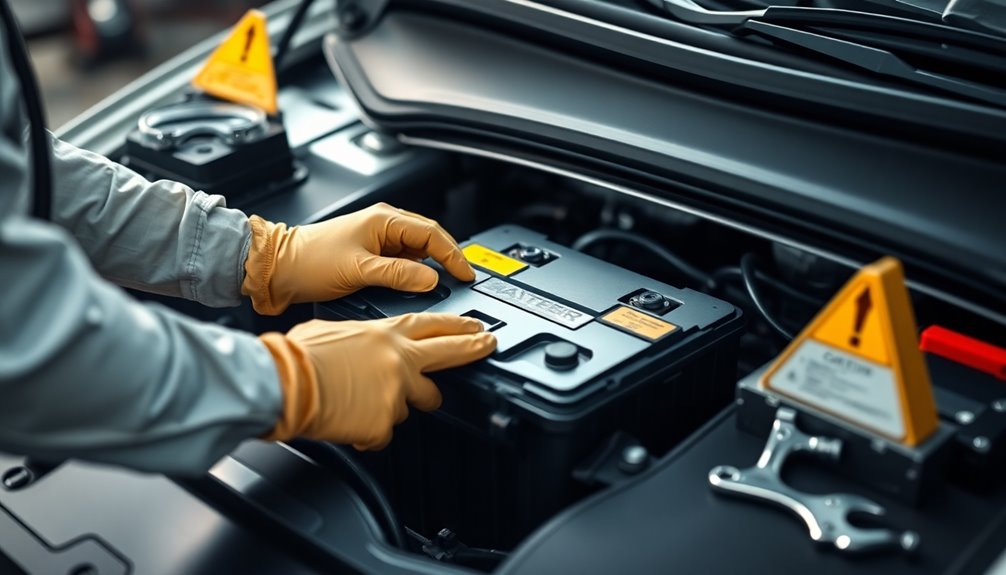
Safety is paramount when dealing with car batteries, so taking the right precautions is crucial. Start by wearing approved safety glasses or goggles to protect your eyes. It's also essential to don proper clothing that shields your face, hands, and body from potential spills or accidents. Don't forget gloves; they'll keep your skin safe from battery acid. Always remove any metal jewelry to avoid accidental contact with the battery terminals.
Before you dive into the task, ensure the vehicle is prepared. Turn off the ignition, remove the keys, and make sure the car is in park with the handbrake engaged. Keep the remote key fob away to prevent unintended operation. Proper vehicle preparation is vital to prevent accidental starts or movements during the battery replacement process.
When handling the battery, never lean over it; this keeps you safe from potential acid splashes. Keep the work area well-ventilated to avoid inhaling harmful fumes. Use insulated tools to prevent sparks, and always lift the battery with care to avoid strain on your back.
Remember to secure the new battery in the tray and connect the terminals properly once installed. Following these safety precautions will help you work on your vehicle confidently and effectively.
Terminal Cleaning
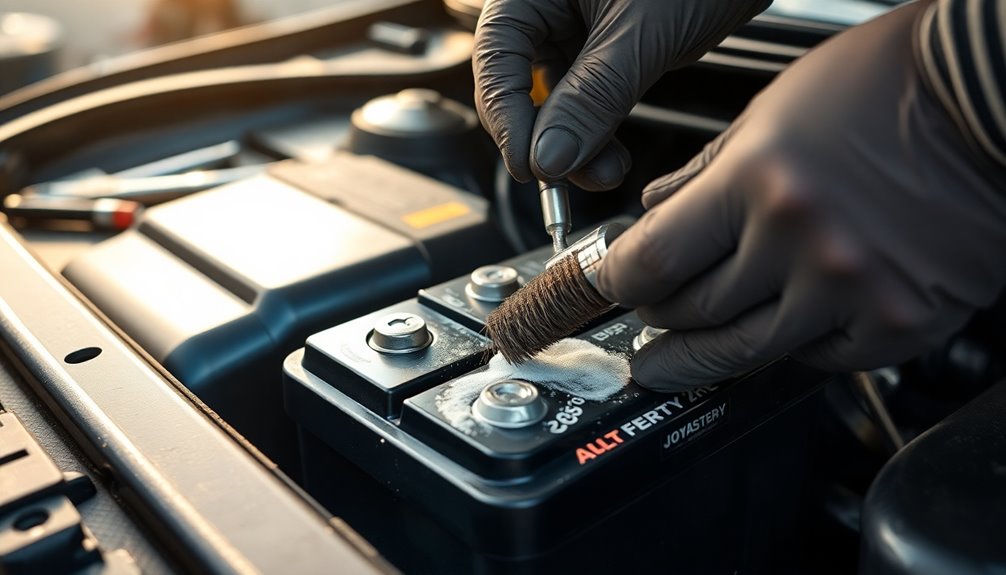
When you install a new car battery, cleaning the terminals is essential for ensuring a reliable connection. Start by turning off the engine. Disconnect the negative battery cable first, marked by the (-) sign, usually black, followed by the positive cable, marked by the (+) sign, typically red. If you notice severe corrosion, loosen any bolts and wiggle the connectors to remove them.
Next, mix one tablespoon of baking soda with one cup of water to create a cleaning solution. Apply this mixture to the terminals and any affected areas. Use a stiff-bristle brush, wire brush, or an old toothbrush to scrub away the corrosion. Rinse the terminals with clean water to eliminate any baking soda residue, and repeat the cleaning if necessary. Make sure to dry the terminals completely with a dry rag to prevent moisture buildup. It's also wise to clean the battery tray, removing any debris, rust, or corrosion.
Additionally, when cleaning the terminals, it's important to use protective gloves to ensure safety and prevent skin irritation from the cleaning solution. Finally, for added protection against future corrosion, apply a thin layer of petroleum jelly or dielectric grease to the cleaned terminals. Regular inspections and cleaning will help maintain optimal battery performance.
Battery Installation Steps

Installing a new car battery is a straightforward process that can be handled with a few essential steps. Start by parking your vehicle on a dry, flat surface and engaging the parking brake. Ensure the ignition is off and let the vehicle cool if it's warm. Don your safety goggles and gloves, and avoid loose clothing to prevent any accidents.
Begin by disconnecting the negative (black) terminal first, using a wrench or ratchet to loosen and remove the clamp. Next, disconnect the positive (red) terminal. Safely move the disconnected cables out of the way.
Remove any clamp or bar holding the old battery in place, then carefully pull it out and set it aside. Position the new battery in the tray, ensuring the terminals align with the connectors. Secure it with the restraint or clamp.
Now, connect the positive terminal first, tightening the clamp until snug, followed by the negative terminal. Be sure to follow safety precautions to prevent accidents during the installation process. Avoid over-tightening to prevent damage. Finally, double-check all connections to ensure they're secure.
Start the vehicle to confirm everything is functioning correctly and enjoy your renewed power!
Restoring Vehicle Settings

After securing your new battery, you'll want to restore your vehicle's settings, as replacing the battery can disrupt various electronic systems. If you have a newer vehicle, consider using a battery memory saver. This handy tool connects to your vehicle's OBDII port or cigarette lighter to maintain power, preventing the loss of ECU memory, radio presets, and other settings.
Next, identify and reset any affected systems. The adaptive electronic control unit (ECU) memory might need a reset, and you'll likely need to reconfigure your radio codes, presets, and clock. Check your owner's manual for specific instructions, as some systems may restore automatically after a short drive, while others require manual intervention. Additionally, using a BMS can significantly streamline this process by keeping essential functions active during the battery change.
If necessary, perform a full reset by disconnecting the battery and waiting 15 minutes to an hour for residual power to dissipate. This resets the ECU to factory settings, allowing it to relearn your driving habits.
Finally, don't forget to restore specific settings like your navigation system, seat positions, and infotainment preferences, which might require reconfiguration or even a scan tool for certain electrical systems.
Engine Testing

With your new battery securely installed, it's time to conduct engine testing to ensure everything is functioning properly. First, double-check that the battery is correctly installed and that all terminals are clean and free from corrosion. If you used a battery memory saver during the installation, verify that it's been removed.
Next, check the battery hold-down strap to make sure it's tightly secured.
Using a multimeter, measure the open circuit voltage at the battery terminals; it should read 12.6 volts or above with the engine off. Start the engine and measure the voltage again; it should be around 14.7 volts if the alternator is working properly. Regular battery checks are essential because 46% of breakdowns in 2022 were attributed to battery issues.
Don't forget to monitor the voltage drop while the headlights are on; it shouldn't fall below 11.6 volts.
To perform a load test, apply a load equal to half the battery's Cold Cranking Amps (CCA) rating for 15 seconds, ensuring the voltage remains above 9.6 volts throughout.
Lastly, check that the CCA rating meets the manufacturer's recommendations. These steps will help confirm your new battery is ready for optimal performance.
Long-Term Maintenance
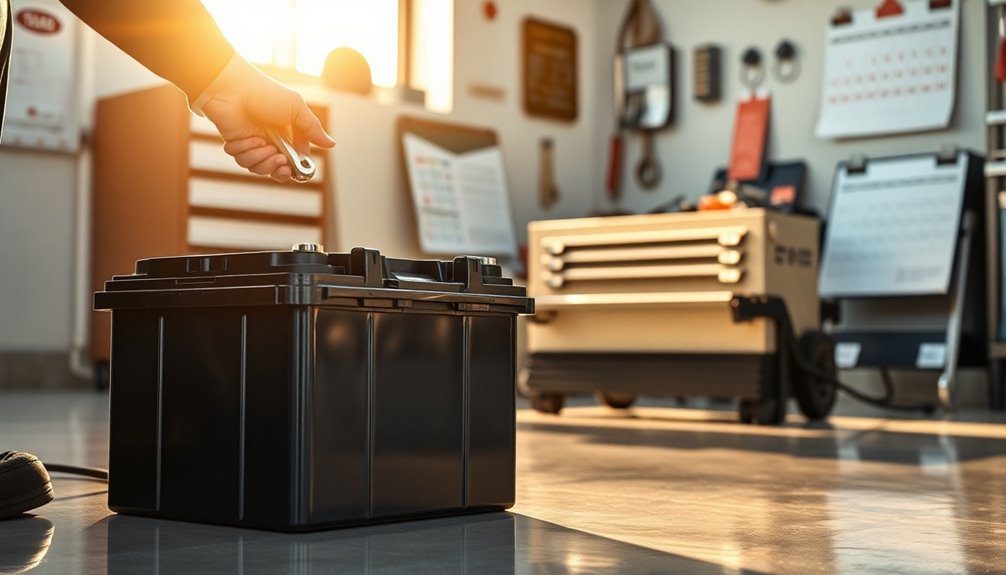
Taking care of your new car battery is crucial for ensuring its longevity and performance. Start by cleaning the battery surface regularly with a damp cloth or battery cleaning solution to prevent dirt and grime buildup.
Make sure the battery terminals are free from corrosion; use a terminal cleaner or wire brush as needed. Keeping the battery tray clean is equally important, as it prevents dirt from draining your battery's power.
Develop good driving habits by using your car regularly, since the alternator recharges the battery during drives. Avoid frequent short trips that can quickly drain the battery. Instead, combine errands into longer drives to give the alternator enough time to recharge fully.
Before turning off the engine, remember to switch off all electrical components to prevent unnecessary drain. Regular maintenance practices, such as cleaning battery terminals, can significantly extend the lifespan of your battery.
If you're storing your car for a while, use a trickle charger to maintain the battery's charge. Regularly check the battery water levels and top up with distilled water if necessary.
Lastly, document your battery replacement and keep records for future reference, ensuring you're always informed about your battery's health.
Monitoring Battery Performance

Monitoring your car battery's performance is essential for ensuring it operates efficiently and lasts as long as possible. Start by regularly checking battery voltage and cranking current signals, as these metrics give you a clear picture of your battery's health.
Real-time voltage monitoring allows you to detect abnormalities, predict performance issues, and address them before they escalate. Proper monitoring technologies ensure timely detection of issues during operation.
Consider investing in a Battery Management System (BMS), which acts as the intelligent brain of your battery. A BMS can provide real-time health assessments, predict performance indicators, and prevent overcharging or discharging, ultimately extending your battery's lifespan.
You should also track key performance metrics like Cold Cranking Amps (CCA) and Reserve Capacity (RC). These figures will help you understand your battery's ability to start your engine and support modern electrical systems.
Finally, utilize diagnostic tools and algorithms to keep tabs on your battery's condition. Devices like OBDII readers or software tools such as Recurrent Reports can offer detailed evaluations of your battery health and performance, enabling timely corrections and ensuring your battery runs smoothly.
Frequently Asked Questions
How Do I Know if My Battery Is Compatible?
To know if your battery's compatible, start by checking the size and type against your old battery or your owner's manual.
Verify the terminal placement matches your car's configuration—positive and negative should align correctly.
Next, confirm the voltage is 12V and the Cold Cranking Amperage (CCA) meets or exceeds the manufacturer's specifications.
Lastly, consult auto parts store staff or reliable online resources for additional guidance on compatibility.
What Tools Do I Need for Battery Installation?
When you're installing a new car battery, you'll need several tools to make the process smooth.
Grab a socket wrench and a ratchet set for disconnecting and connecting terminals. A wire brush helps clean the terminals, while safety gloves and goggles protect you during the job.
If your battery has corrosion, consider using an anti-corrosion solution.
Finally, a battery hold-down clamp secures the battery in place, so it stays put while you drive.
How Often Should I Replace My Car Battery?
You should replace your car battery every 3 to 5 years, depending on various factors.
Extreme temperatures, frequent short trips, and leaving accessories on can shorten its lifespan.
If you notice signs like engine sputtering, dim headlights, or physical wear like corrosion, it's time to consider a replacement.
Regular maintenance and testing can help extend your battery's life, so keep an eye on its performance to avoid unexpected failures.
Can I Install a Battery by Myself?
Yes, you can install a battery by yourself! Just make sure you've got the right tools and safety gear.
Start by turning off the ignition and disconnecting the old battery correctly. Clean the battery tray and connect the new battery with the positive terminal first.
It's crucial to secure it properly and check for any corrosion. If you follow the steps carefully, you'll have your new battery installed in no time!
What Are Signs of a Failing Battery?
If you're noticing signs of a failing battery, pay attention to how your engine starts. A slow crank or a clicking sound when you turn the key can indicate trouble.
Dim or flickering headlights also suggest weak power. Check for physical signs like swelling or corrosion, and be wary of any odd smells.
If your battery struggles in cold weather or shows low voltage, it might be time for a replacement.
Conclusion
Now that you've installed your new car battery, it's crucial to take a few extra steps to ensure it performs at its best. By following safety precautions, cleaning the terminals, restoring vehicle settings, and regularly testing the engine, you're setting yourself up for success. Don't forget to monitor the battery's performance over time to catch any issues early. With a little care, your new battery will keep your vehicle running smoothly for miles to come!

